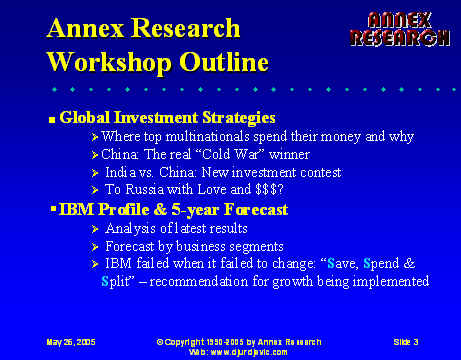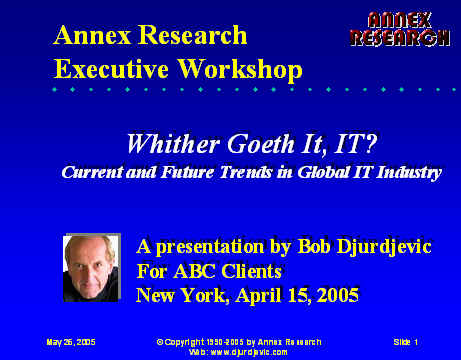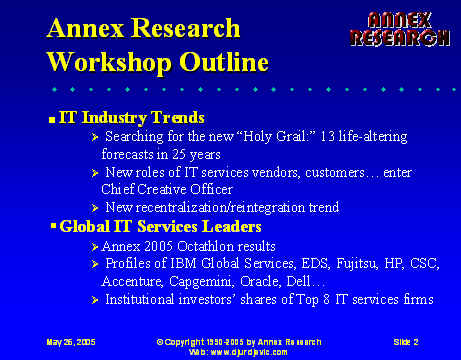
Home | Headlines | Annex Bulletins | Index 2005 | About Founder | Search | Feedback | Clips | Activism | Client quotes | Workshop | Columns | Subscribe
![]()
This Djurdjevic workshop will:
- Allow you to pick the brains of one of world's foremost IT industry analysts for a full day
- Teach you how to think globally in planning for future
- And to read between the lines of vendors' or politicians' declarations...
Executive Workshop - Sample Outline

![]()
IT Industry Trends
Industry Stratification
In early 1988, we prophesied a need for leasing vendors to diversify away from hardware deals. In March 1990, we said that the "computer industry" would have to reinvent itself; that the value shift from hardware to software and services would lead to new breed of lessors, users and vendors. At the workshop, you'll find out who will make it and who won't.
Upsizing of America
Contrary to what one may conclude from the gloomy daily headlines (about downsizing and job losses), an upsizing of America is under way. Find out which parts of the market and growing and how they are fueling America's (and global) economic growth.
Services and Outsourcing
Nowadays "everybody" is or wants to be in the services business. But what does it really mean? Who are the leaders in this new field? Who is doing well, and why? Who is not, and why not? You'll learn all that and more about the leading global IT services vendors, such as EDS, IGS, Accenture, Hewlett Packard, Cap Gemini Ernst& Young (CGE&Y), Computer Sciences Corp. (CSC) etc.
If PCs Could Fly...
IT vendors spend a lot of time complaining about a lack of standards. But we are more worried about a lack of buyers’ standards, especially in the PC part of the industry. As a result, shoddy products proliferate as "winners." Find out about the issues and proposed solutions.
![]()
Global Trends
Where "Top 100" Multinationals' Invest Their Money - A Close Look at the World’s "Emerging Markets" (China, Latin America, S.E. Asia, Russia, E. Europe)
A "Klondike of the 21st century," or a "Big Bust?" The Chinese shot at democracy; the Russians shot in the name of democracy. Find out who the world's top 100 multinational companies rewarded, and who they punished. Based on the latest U.N. statistics, you will learn who these global business leaders are, what they are up to, and what they are not likely to do. The session incorporates our geopolitical foreign policy scenarios. It is a "must" for any global strategic thinker. And our "Yikes" and "Yahoos" list will update you about the "has beens" and the "newcomers" to the "Top 100" list. Does protectionism pay? Find out at our next workshop.
End of Western Dominance? Not in Our Lifetime...
Check out the 25-year forecast by the World Bank. Find out which nations will end up on top, and which ones will end up at the bottom of the economic pecking order in year 2020. It implied that the era of western dominance was at an end. Contrast that with our analysis of the World Bank forecast. You will see that we draw substantially different conclusions about the future from basically the same "raw" data. A key difference: we don't use history to forecast the future, as the WB bureaucrats did. We use our "big picture" grasp of global affairs, and add to it our intuition, and logical extrapolations based on practical experiences.
(Re)Fusion of Arts and Science
If a reporter asked Leonardo Da Vinci if he were an artist or a scientist, what would Da Vinci’s answer have been? See how the industrial era’s shortcomings warped human nature, and how the information era opportunities will help return humanity back to its roots. Should we be hiring more musicians and fewer engineers to get ready for the fusion of arts and sciences?
![]()
IBM Trends & Strategies
Remaking IBM for the 21st Century
For most of its first eight decades of existence, IBM has been a standout, outgrowing the U.S. GNP by a two-to-one margin. By the early 1980s, the company seemed to be able to walk on water. But by the early 1990s, the Big Blue became a laughing stock of corporate America. Now IBM seems to be coming back again. But is its recovery for real? How long will it last? You'll find out the answers to these and other questions at this workshop.
IBM Software Challenges
In July 1984, well before most people thought of software as a big business, we predicted that the IBM software prices would skyrocket. In early 1985, we suggested that IBM will have to find new ways of pricing the software, e.g., usage-based charges, or "metered" software.. In late 1986, we spoke of "free MIPS," and that most of the money will be made in software and services. Since that time, these things have materialized. And now, IBM’s software is a $12.7 billion business. But new challenges lie ahead. Putting IBM software on the desktop is one - enter Lotus...
IBM and the Internet
Making IBM aggressively participate in the Internet revolution is another challenge. Find out at the workshop about IBM’s OnDemand strategies. Learn about why the IT industry may be coming back the IBM way. And what strategic moves can be expected in the future.
IBM Global Services' Changing Strategic Role
Since its inception in May 1991, IBM Integrated Systems Solutions Corp. (ISSC), now known as IBM Global Services (IGS), has been the fastest growing part of IBM. In May 1994, its industry-oriented structure became the blueprint for all of IBM. Now that the 1956 Consent Decree has been lifted, IGS faces new strategic options. Find out what they are, and what's ahead for IGS, IBM's largest business unit - now also the biggest services operation in the world.
![]()
IBM: Five-year Forecast
Should IBM Be Broken-up? What Will It Take to Return IBM to Growth Again?
The session will end with our traditional five-year financial forecast for IBM. 1994 was the first profitable year since 1990, as we had predicted going into it. In 1995, the earnings improved some more, as they did in the next two years. But then, IBM, hit the wall. Its earnings peaked in 1998, as the former CEO Gerstner refused to break up the Big Blue, as we recommended in 1996. Ever since, IBM has been basically stagnating, as revenue have actually declined. At the Annex workshop you will find out what IBM new management under Sam Palmisano need to do to turn things around, and return IBM to growth.
![]()
SPECIAL SESSION: IT Industry Leaders Profiles
Besides EDS, IGS, Accenture, Hewlett Packard, Cap Gemini Ernst& Young (CGE&Y), Computer Sciences Corp. (CSC) which we mentioned earlier, you may also learn more about other global IT leaders: Microsoft, Oracle, Fujitsu, SUN, HP, Dell...
The industry stratification trend has already given us some clues about what types of companies will end up at the top of the food chain by the end of this decade. In this session, we examine many of the leading current industry leaders' business performances and strategies, to see how they are positioned for the "brave new world" of software and services.
Also see What Others Have Said..., including some comments by past Annex Executive Workshop attendees.
| Bob Djurdjevic runs his workshops interactively, allowing time for questions and
exchanges of ideas.
Please call 602-824-8111 for more information e-mail us. |
|---|
![]()
Home | Headlines | Annex Bulletins | Index 2003 | About Founder | Search | Feedback | Clips | Activism | Client quotes | Workshop | Columns | Subscribe

